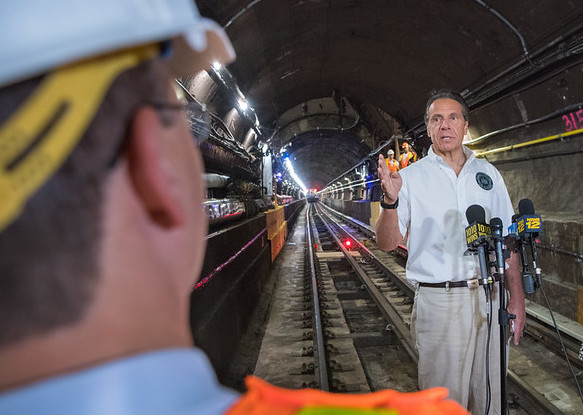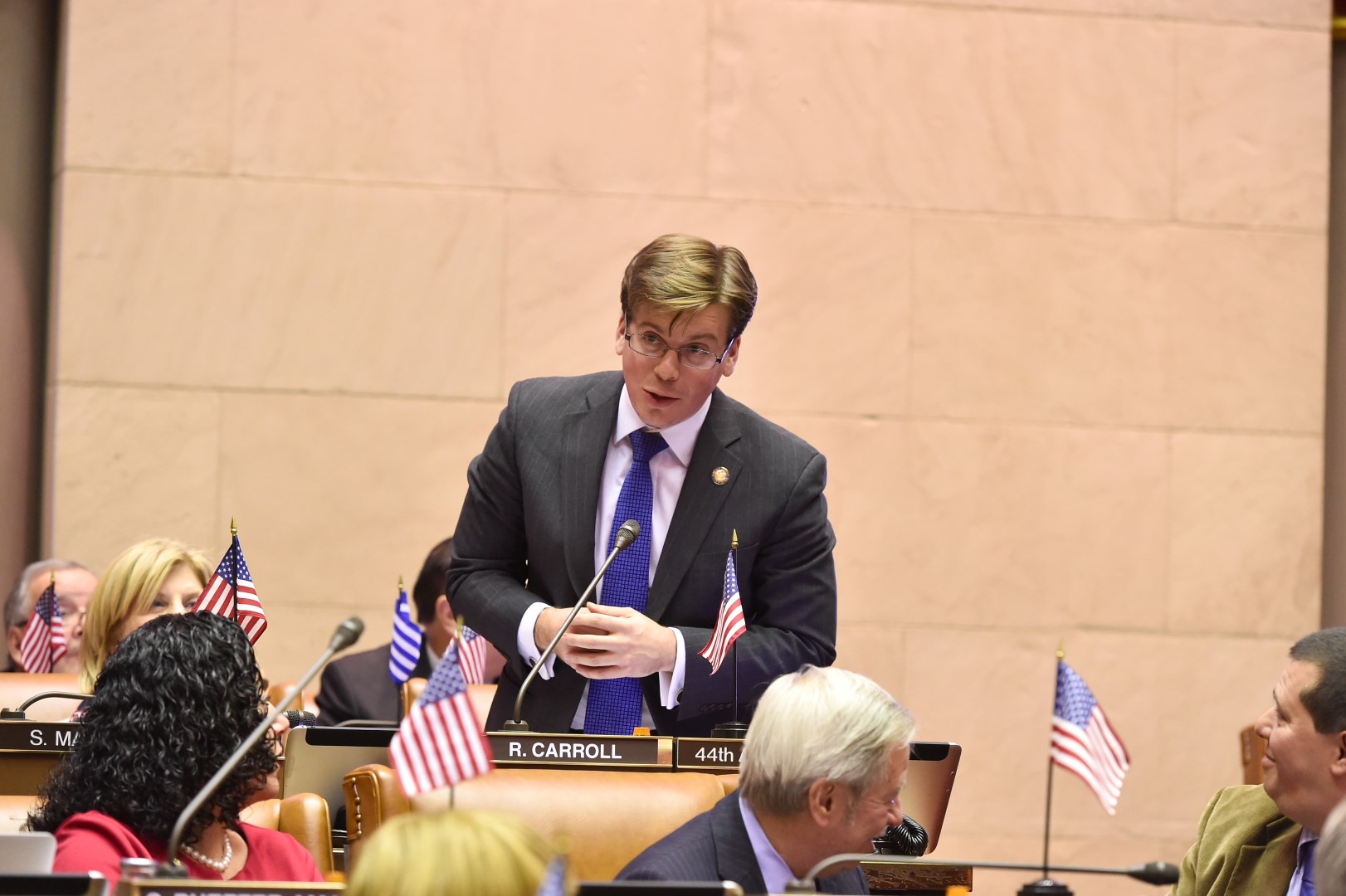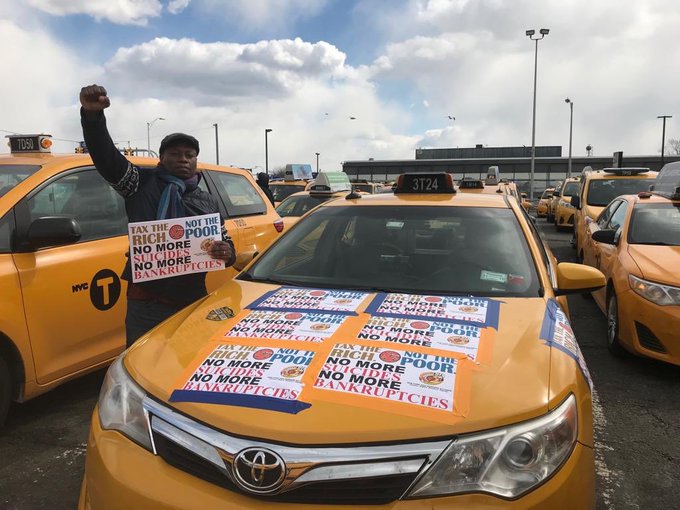Shut Down the Subway – and Fix It

Gov. Cuomo should close the subways, the author writes (photo: Governor's Office)
New York City is the epicenter of the coronavirus crisis in the United States. State and city authorities are pleading with residents to stay home, shelter in place, and maintain distance from fellow New Yorkers to slow the wave of cases crashing into the city’s healthcare facilities.
Yet, public transportation was running on the standard weekday schedule as of Monday morning. With subway ridership down ridership down 87%, the response on Tuesday was to cut trains by a quarter.
Such quarter-measures will not serve the city well. A full closure of the subway is needed, along with steps to dedicate buses and other transportation services to the essential workers who are saving lives and keeping the city running. As drastic and disruptive as shutting down the subway sounds, doing so can slow the spread of the virus. Apart from the exigency of the public health crisis, the unprecedented fall in ridership also offers an opportunity to undertake repairs and fixes that would be disruptive in normal times -- and help set the stage for the system’s recovery.
There is an irreconcilable tension between running public transport essentially as normal while authorities order folks to stay at home. Public transportation accounts for most trips within the city, and the virus travels alongside passengers in the confined spaces of trains and buses. Public transit was suspended on the first day of the lockdown in Wuhan, China in order to slow the circulation of people and the virus they may carry, and Chinese public health officials have urged cities to suspend service in other affected countries. MTA workers -- not to mention CEO Patrick Foye -- are falling ill themselves and the decision to run fewer trains has increased crowding, and thus transmission risks.
The MTA needs to immediately cease providing fully “public” public transportation. Addressing this crisis requires taking seriously the real economic, social, and health costs of continuing to provide service, and beginning to think about how the system can recover after the crisis.
The MTA should shut down all subway lines and use the time for several weeks’ worth of dedicated repairs, accomplishing fixes that would in normal times have to be stretched over months or years. Typically, major disruptions to train operations for necessary repairs are impossible or at least extremely difficult due to rider pushback, even when closures allow for faster and cheaper progress.
The subway is the circulatory system of New York City. In drastic open-heart surgeries, the heart is stopped and damage repaired to help the patient come back healthier. Taking advantage of a time when circulation needs to halt to ensure the health of the subway when it restarts is prudent and will allow New York to come back from this crisis stronger than before.
This would be an effective use of money set aside for public transportation in the new federal stimulus bill, and closure will also help strengthen existing shelter-in-place orders to slow the spread of the virus throughout the city. With ridership already at historically low levels, coupled with an imperative to minimize travel, the typical disruptions from repairs are minimized. Making progress on the extensive backlog of much-needed repairs to dilapidated stations, outdated power systems, and other priorities while advancing progress on essential signals upgrades will help the subway emerge more reliable and faster for New Yorkers after the crisis, which will help the system more quickly recover ridership.
There are, of course, major logistical challenges that must be overcome to make such a plan workable. For one, healthcare providers and other critical workers need to get to their jobs. MTA buses should be dedicated to the transport of essential workers only, maintaining existing routes on streets cleared of competing traffic. For essential workers unable to commute by bus, the city should draw on its taxi fleet to provide alternative transportation or partner with app-based services.
Care will also need to be taken to ensure the health of workers undertaking repairs. Workers will need to be screened (at least for their temperatures, if coronavirus testing delays persist), worksites will need to be consistently monitored for transmission risks, and workers must be provided guaranteed care in the case that transmission does occur on the job. Practices and procedures will have to be adapted to match the needs of these unusual times.
Slowing the spread of the coronavirus in New York requires dramatic actions, and halting public transportation to reinforce existing orders is just one needed step. Stopping the trains now and using the time to make necessary repairs can also lay the foundations for New York’s recovery by creating the opportunity for the city, and its public transportation, to bounce back better than before.
***
Patrick Farrell is a Master in Public Affairs student concentrating in economics and public policy at Princeton University with prior experience as a researcher focused on urban economics at New York University. He is a co-author of the article Social Connectedness in Urban Areas, which explores the distribution of social networks in New York City and the role of public transit in shaping them.
***
Have an op-ed idea or submission for Gotham Gazette? Email This email address is being protected from spambots. You need JavaScript enabled to view it.
State Budget Negotiations are Focused on the Wrong Priorities; We Need an Emergency Coronavirus Package

Assemblymember Carroll, the author (photo: New York State Assembly)
In a few days the New York State Legislature will pass a new state budget. In a normal year, this is the most consequential task the Legislature does. In a crisis year, it may be the last thing we do.
What we do now could help New Yorkers weather the storm. Unfortunately the discussions we are having, which are few, are emphasizing the wrong issues.
To understand New York’s politics, one must understand that New York’s budget is not just dollars and cents, but also a way to enact legislation. In normal years, this is a poor way to run government because it stifles debate and lacks transparency. In a year where the Legislature cannot meet in large groups and advocates and stakeholders are quarantined, it is downright anti-democratic.
Currently, via text and conference calls, the Legislature is discussing Medicaid cuts and big policy decisions like legalization of marijuana and gestational surrogacy, and rolling back bail reform. This is frustrating and frightening. Governor Cuomo has done a phenomenal job in responding to the coronavirus (COVID-19) outbreak, but he is acting like this year’s budget process is no different than last year’s.
There is a common-sense solution to this problem. Push off major policy debates and legislation that are not connected to COVID-19.
This includes policy issues I support, like the legalization of adult use marijuana and surrogacy, and issues I don’t support, like rolling back bail reform or creating new criminal penalties. Rolling back bail reform is especially distressing since we know jails and prisons are particularly vulnerable to epidemics. No one deserves to die from coronavirus, but it would be especially tragic if individuals held in detention died awaiting trial on minor charges. Sticking to criminal justice, Governor Cuomo should be bold and release prisoners who have served at least 50% of their sentence and are vulnerable to COVID-19 due to age or underlying health conditions. Our prisons are bad enough, we should not allow them to become death traps.
Thankfully, the governor has moved the presidential primary from April 28 to June 23, but now the Legislature must act to protect every New Yorker and ensure participation in our elections by mailing every New Yorker a ballot for the primary and general elections.
Second, we should suspend rent payments for the next 90 days for residential and commercial tenants who lost their job or business due to coronavirus. Landlords should get a similar reprieve from mortgage payments in an amount consistent with their lost rent. The governor already barred foreclosures and evictions for 90 days, this is the logical next step.
Third, we should require insurance companies to honor business interruption insurance. It is unconscionable that insurance companies that were bailed out in 2008 won’t pay out business interruption policies because they say “viruses” were either explicitly carved out of policies or because adjusters claim a “virus” is not a “physical” interruption.
Last and most importantly, we cannot cut Medicaid. Yes you heard that right – the current state budget plan, as outlined by the governor, would cut Medicaid funding to some of our neediest communities and hospitals. What we need to do is increase funding to our hospitals and other critical pieces of infrastructure that are currently taxed or are facing severe deficits, like the Metropolitan Transportation Authority (MTA).
The only way to do that is to raise taxes. Raise them on second homes over $5 million, raise them on individual earners over $1 million, raise them on luxury goods, or charge fees on non-essential online deliveries. No matter what we do, we need the revenue because the federal stimulus has not addressed lost state revenue.
In the last 20 years, New York lost thousands of hospital beds because of a medical system that is built on profit. Land that was valuable was sold to real estate speculators and hospital beds were lost. We had our priorities out of whack. Let’s not do it again. Governor Cuomo, if you are able to do all that and get the Legislature to go along with it, #CuomoForPresident will no longer just be trending on Twitter and might just become a reality.
***
Assemblymember Robert Carroll is a Democrat who represents Park Slope, Windsor Terrace, Kensington, Ditmas Park, and other neighborhoods. On Twitter @Bobby4Brooklyn.
***
Have an op-ed idea or submission for Gotham Gazette? Email This email address is being protected from spambots. You need JavaScript enabled to view it.
Coronavirus Crisis Presents Opportunity for the City to Finally Step Up for Struggling Taxi Drivers

Taxi drivers push for help (photo: @NYTWA)
In the past month, the coronavirus pandemic has brought our world to a standstill, causing emotional and financial hardships for Americans around the country. As schools, restaurants, and retailers across New York shutter indefinitely, it is clear that no industry, or worker, will go unaffected.
Among those hit hardest, however, will be New York’s over 21,000 yellow and green taxi drivers, who have already been struggling to survive in the wake of the financial ruin of the medallion debt crisis.
Just weeks into unprecedented travel restrictions, event cancellations, and shelter-in-place policies, taxi workers are already feeling the crushing weight of lost business worse than most. Recent reports describe drivers searching for hours without being able to pick up a single fare, to say nothing of the heightened risk they face of catching the virus if they are even lucky enough to get a few fares during a shift.
For New York’s taxi drivers, the coronavirus pandemic has exponentially exacerbated the financial problems they faced before the outbreak, with no end in sight. As the coronavirus outbreak worsens, however, it doesn’t need to be so devastating for taxi drivers. In fact, it could be what finally brings about needed, lasting change to the industry.
As has come to light in recent years, the value of taxi medallions was recklessly and artificially raised by powerful industry insiders and city government for nearly a decade. The resulting bubble was frighteningly identical to the housing market crash that set off the Great Recession in 2008, trapping thousands of low- to middle-income owner-drivers, many of them immigrants, into sub-prime loans. Only instead of losing their homes, taxi workers lost their businesses and livelihoods.
Both city government and the lending industry share blame for where the taxi industry is today. While the city’s Taxi and Limousine Commission made over $800 million off medallion sales between 2004 and 2014 alone, it is the predatory lenders who nefariously created unfavorable contracts with paralyzing interest rates and conditions. The predictable result was countless taxi owner-drivers saddled with hundreds of thousands of dollars in debt on an investment they were falsely promised could never fail.
Now it is time to act.
While New York rolls out programs to support small business owners and gig workers alike during this unprecedented public health and economic crisis, the city cannot and must not again fail the taxi drivers it failed to protect once before. Mayor de Blasio has already announced his administration will offer zero interest loans to small businesses that have experienced a loss of revenue because of the coronavirus fallout. A similar program should be created for taxi drivers, whose medallion-licensed taxis are themselves small businesses. It’s encouraging that a new temporary program will give TLC licensed drivers jobs delivering food to senior citizens who can't leave home during the shelter-in-place order.
But these programs are simply stopgaps that will make conditions for taxi workers more tolerable during this crisis. What taxi workers truly need is a path away from the debt that weighs them down and towards a more sustainable, financially sound future.
Just weeks before the coronavirus outbreak began, a City Council-created commission produced a report outlining how the City could steer the city’s taxi owner-drivers out of their debt struggles and into a successful future. Core to the proposal was leveraging public-private partnerships in which mission-driven firms such as ours work with taxi drivers to provide the necessary structural and technological changes they need to be competitive with the likes of Uber and Lyft.
Though it should have been done years ago, the city must now heed the call to action by Bhairavi Desai and the Taxi Workers Alliance to cancel all medallion owner debt over $150,000, while also guaranteeing them paid sick leave.
While coronavirus has exposed just how vulnerable New York’s taxi drivers are, the city is now facing the perfect moment to take bold action that could help so many hard-working drivers, including many immigrants, and save the yellow taxi industry that is deeply embedded in the fabric of our city. Taking action on the commission’s plan immediately is the only way to truly answer the calls of the Taxi Workers Alliance and their members, and the timing could not be more prudent.
New York left these drivers behind once before. It’s well past time for our city to not only give them a fighting chance to survive this pandemic, but an opportunity to rebuild their business so they can thrive for decades to come.
***
Zahid Biviji and Mihir Dange are the Co-Founders of Wapanda, a mission-driven transportation infrastructure technology platform. On Twitter @Wapandaco.
***
Have an op-ed idea or submission for Gotham Gazette? Email This email address is being protected from spambots. You need JavaScript enabled to view it.




